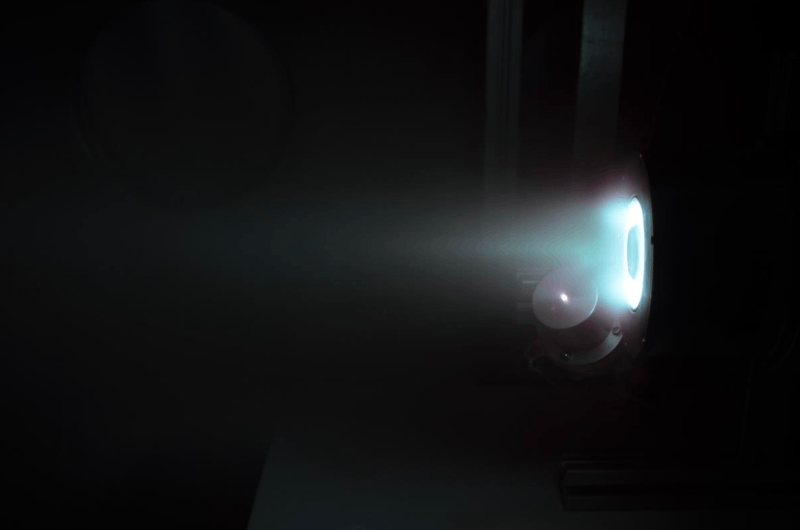Performance Evaluation of Pulsar Fusion’s 500W Hall Effect Thruster with Integrated LaB6 Cathode Using Xenon Propellant
Author: Pulsar Fusion UK Ltd.
Affiliation: Pulsar Fusion, Bletchley, UK
Abstract
This whitepaper presents an analysis of experimental performance data from Pulsar Fusion’s 500 W Hall Effect Thruster (HET), designated the LeoBear model, equipped with an in-house LaB₆ cathode. Tests were conducted using xenon (Xe) propellant across discharge voltages of 200–500 V and anode flow rates between 8–14 sccm (0.72–1.25 mg/s), achieving power levels from ~162 W to ~775 W. Key metrics evaluated include thrust, specific impulse (Isp), anode efficiency, and total efficiency.
Results indicate stable ignition and reliable operation across a wider flow-rate envelope compared to krypton. At nominal 500 W operation, the thruster achieved ~21,7 mN thrust, ~2058 s Isp, and anode efficiencies exceeding 40%. Stable operation was maintained down to ~0.72 mg/s Xe flow, significantly lower than krypton’s ~1.12 mg/s limit. Maximum tested power approached 700 W, producing thrust up to ~28 mN, Isp of ~2300 s, and peak anode efficiency near 49%.
These findings demonstrate that xenon offers superior operational stability, higher Isp, and improved efficiency relative to krypton, confirming the LeoBear HET’s suitability for a wide range of small satellite propulsion applications.
1. Introduction
Hall Effect Thrusters (HETs) remain a leading class of electric propulsion, widely adopted for orbital manoeuvres, station-keeping, and interplanetary missions. While krypton has recently gained attention as a cost-effective alternative propellant, xenon remains the industry standard due to its superior ionisation characteristics.
The Pulsar Fusion LeoBear 500 W HET incorporates a LaB₆ cathode, chosen for its high electron emissivity, thermal robustness, and potential for extended operational lifetimes. This paper reports a performance characterisation of the LeoBear with xenon propellant under laboratory vacuum conditions, highlighting operational stability, thrust scaling, and efficiency gains compared to krypton.
2. Experimental Setup
Testing was performed at Pulsar Fusion’s vacuum facility. The LeoBear HET was mounted on a calibrated thrust stand with a sensitivity coefficient of 0.000874 mm/mN and offset of 0.001562 mm. Displacement was measured via laser interferometry.
Xenon was delivered at anode flow rates between 8–14 sccm (0.72–1.25 mg/s) and cathode flow at ~8 sccm (0.72 mg/s). Discharge voltages ranged from 200–500 V with currents adjusted to achieve target powers. Keeper voltages were ~33 V with currents of ~1.0 A. Inner and outer magnet circuits operated stably at full current from startup, without requiring ramp-up.
At the time of testing, the thruster had accumulated nearly 200 hours of prior firing, and thus was no longer at beginning-of-life (BoL); vacuum chamber pressure during operation was maintained at ~1×10⁻⁵ mbar.
hermocouples were mounted on the inner magnet and thruster base. Temperatures were logged at 1 Hz.
3. Results & Discussion
3.1 Data Points





3.2 Performance Metrics
The thruster was evaluated across operating points between 200–500 V and 8–14 sccm Xe flow, covering powers from ~162 W to ~775 W. Results are presented in two regimes: low-power (200–400 W) and high-power (600–800 W equivalent range).
3.3 Low-power operation (200–400 W)
- Maximum thrust observed: ~19.7 mN at 14 sccm, 250 V.
- Highest Isp recorded: ~1780 s at 12 sccm, 300 V.
- Peak anode efficiency: ~41% at 12 sccm, 300 V.
3.4 High-power operation (600–800 W):
- Maximum thrust achieved: ~28 mN at 14 sccm, 375 V (686 W).
- Highest Isp observed: ~2547 s at 12 sccm, 500 V.
- Peak anode efficiency: ~49% at 350 V, 14 sccm.
Thrust scaled linearly with power (r ≈ 0.96), while Isp increased with discharge voltage. Efficiencies improved at higher voltages and flows due to enhanced plasma confinement. Across the tested range, anode efficiency consistently exceeded 40%, with a maximum observed near 49% under optimised conditions.
3.5 Operational Stability
Compared to krypton, xenon enabled stable operation down to lower flow rates (0.72 mg/s vs. 1.12 mg/s for krypton). This reflects xenon’s higher ionisation cross-section and lower ionisation energy. Operators reported no need to gradually increase magnet currents; the thruster remained stable with full magnet current from startup, simplifying test sweeps.
3.6 Thermal Performance
Thermal conditions were benign at xenon operating points. Inner magnet temperatures remained below 150 °C, with thruster base temperatures < 60 °C over two-hour runs. No thermal constraints were encountered up to ~700 W.
3.7 Discussion
The LeoBear HET with xenon demonstrated superior low-flow stability compared to krypton configurations, remaining operational down to 0.72 mg/s anode flow versus 1.12 mg/s for Kr. This is attributable to xenon’s larger atomic radius, higher ionisation cross-section (order of 5 × 10⁻²⁰ m² vs. ~4 × 10⁻²⁰ m² for Kr at typical electron energies), and lower ionisation energy, enabling easier plasma sustainment at reduced densities.
Isp values were 10–20% higher than equivalent Kr tests, aligning with theoretical expectations based on propellant mass and ionisation efficiency.
The thruster also fired reliably without the need for electromagnet current ramping, operating stably with full magnet current from ignition. This simplified testing and suggests robustness for on-orbit operations.
Efficiencies peaked at higher flow rates and voltages, with anode efficiency exceeding 40% across the range and reaching ~49% at 350 V, 14 sccm. Total efficiency was limited by fixed auxiliary power, offering opportunities for optimisation in power processing units.
4. Conclusions
The Pulsar LeoBear 500 W HET exhibits excellent performance with xenon propellant, achieving thrust up to ~28 mN, Isp of ~2300 s, and peak anode efficiency near 49% across a broad operating envelope. Stability was maintained at low flow rates, and simplified startup without magnet ramping highlights its robustness. These attributes make the LeoBear HET highly suitable for small satellite constellations and other missions requiring efficient, cost-effective electric propulsion.
References
- Goebel, D. M., & Katz, I. (2008). Fundamentals of Electric Propulsion: Ion and Hall Thrusters. John Wiley & Sons.
- Pulsar Fusion. (2025). Pulsar Fusion Technical Report | Code: PF-LEOBEAR-KR-2025-V2 LAB6.
Pulsar Fusion Technical Report | Code: PF-LEOBEAR-KR-2025-V3 Xe
